Bacon

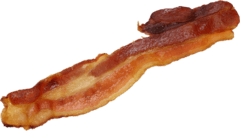
Bacon is a meat product prepared from pork and usually cured.[1][2] It is first cured using large quantities of salt,[2] either in a brine or in a dry packing; the result is fresh bacon (also known as green bacon).[3] Fresh bacon may then be further dried for weeks or months in cold air, or it may be boiled or smoked.[1] Fresh and dried bacon is typically cooked before eating, often by frying. Boiled bacon is ready to eat, as is some smoked bacon, but may be cooked further before eating.
Bacon is prepared from several different cuts of meat. It can be made from side and back cuts of pork or from pork belly. The side cut has less fat than the belly. In the US "bacon" implies belly bacon, with leaner cuts known as "Canadian bacon". In the UK loin bacon, with some belly attached, is known as "back bacon", and belly bacon is termed "streaky".[4] Bacon may be prepared from either of two distinct back cuts: fatback, which is almost pure fat, and pork loin, which is very lean.


.jpg)
Bacon may be eaten smoked, boiled, fried, baked, or grilled and eaten on its own, as a side dish (particularly in breakfasts in North America) or used as a minor ingredient to flavour dishes (e.g., the Club sandwich). Bacon is also used for barding and larding roasts, especially game, including venison and pheasant. The word is derived from the Old High German bacho, meaning "buttock", "ham" or "side of bacon", and cognate with the Old French bacon.[5][6]
In contrast to the practice in the United States, in continental Europe these cuts of the pig are usually not smoked, but are instead used primarily in cubes (lardons) as a cooking ingredient, valued both as a source of fat and for its flavour. In Italy, this product is called pancetta and is usually cooked in small cubes or thinly sliced as part of an antipasto.
Meat from other animals, such as beef, lamb, chicken, goat, or turkey, may also be cut, cured, or otherwise prepared to resemble bacon, and may even be referred to as "bacon".[7] Such use is common in areas with significant Jewish and Muslim populations, both of which prohibit the consumption of pigs.[8] The USDA defines bacon as "the cured belly of a swine carcass"; other cuts and characteristics must be separately qualified (e.g., "smoked pork loin bacon"). For safety, bacon may be treated to prevent trichinosis,[9] caused by Trichinella, a parasitic roundworm which can be destroyed by heating, freezing, drying, or smoking.[10]
Bacon is distinguished from salt pork and ham by differences in the brine (or dry packing). Bacon brine has added curing ingredients, most notably sodium nitrite, and occasionally potassium nitrate (saltpeter); sodium ascorbate or erythorbate are added to accelerate curing and stabilise colour. Flavourings such as brown sugar or maple are used for some products. Sodium polyphosphates, such as sodium triphosphate, may be added to make the produce easier to slice and to reduce spattering when the bacon is pan-fried. Today, a brine for ham, but not bacon, includes a large amount of sugar. Historically, "ham" and "bacon" referred to different cuts of meat that were brined or packed identically, often together in the same barrel.
Curing and smoking bacon
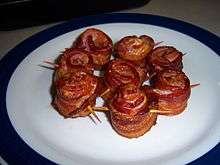
Bacon is cured through either a process of injecting with or soaking in brine or using plain salt (dry curing).[2]
In America, bacon is usually cured and smoked, and different flavours can be achieved by using various types of wood, or rarely corn cobs; peat is sometimes used in the United Kingdom. This process can take up to eighteen hours, depending on the intensity of the flavour desired. The Virginia Housewife (1824), thought to be one of the earliest American cookbooks, gives no indication that bacon is ever not smoked, though it gives no advice on flavouring, noting only that care should be taken lest the fire get too hot.[11] In early American history, the preparation and smoking of bacon (like the making of sausage) seems to have been a gender-neutral process, one of the few food-preparation processes not divided by gender.[12]
In the United Kingdom and Ireland, smoked and unsmoked varieties are equally common, unsmoked being referred to as green bacon.[3] The term streaky bacon refers to belly bacon, due to the prominence of the bands of fat.[13]
Cuts of bacon
Rashers differ depending on the primal cut from which they are prepared:[14][15]
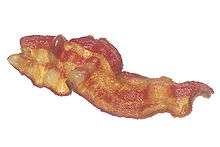
- Side bacon, or streaky bacon, comes from pork belly.[14][15] It is very fatty with long layers of fat running parallel to the rind.[14][16][17] This is the most common form of bacon in the United States.[14]
- Back bacon (rashers) contains meat from the loin in the middle of the back of the pig.[14][16][18] It is a very lean, meaty cut of bacon, with less fat compared to other cuts.[15] Most bacon consumed in the United Kingdom and Ireland is back bacon.[14][19]
- Cottage bacon is thinly sliced lean pork meat from a shoulder cut that is typically oval shaped and meaty.[14] It is cured and then sliced into round pieces for baking or frying.[14]
- Jowl bacon is cured and smoked cheeks of pork.[20] See Guanciale.
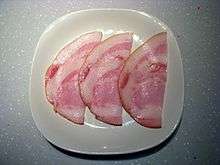
- Slab bacon is side bacon that is not sliced.[15] It generally has the rind still intact, and usually has a medium to very high fraction of fat.[15] It is made from the belly and side cuts, and from fatback.[14] Slab bacon is not to be confused with salt pork, which is prepared from the same cuts, but is not cured.[14]
Bacon joints include the following:
- Collar bacon is taken from the back of a pig near the head.[14][21]
- Hock, from the hog ankle joint between the ham and the foot.[14][22] See Ham hock.
- Gammon, from the hind leg,[14] traditionally "Wiltshire cured".[23] See Gammon (meat).
- Picnic bacon is from the picnic cut, which includes the shoulder beneath the blade.[14][24] It is fairly lean, but tougher than most pork cuts.[14]
Around the world
Bacon is often served with eggs and sausages as part of a full breakfast.[25] Historically, the skin left on the cut is known as 'bacon rind',[26] but rindless bacon is also common throughout the English-speaking world. The meat may be bought smoked or unsmoked.
Australia and New Zealand
The most common form sold is 'middle bacon', which includes the more of the streaky, fatty section of side bacon along with a portion of the loin of back bacon. In response to increasing consumer diet-consciousness, some supermarkets also offer the loin section only. This is sold as 'short cut bacon' and is usually priced slightly higher than middle bacon. Both varieties are usually available with the rind removed.[27]
Canada
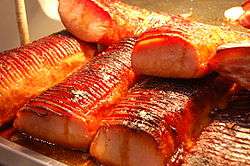
An individual piece of bacon is a 'slice' or 'strip'. In Canada:
- The term 'bacon' on its own typically refers to side bacon.[28]
- 'Back bacon' refers to either smoked or unsmoked bacon cut from the boneless eye of pork loin;[28] this is called 'Canadian bacon' in the United States when cut into a thick medallion shape.
- Peameal bacon is back bacon, brined and coated in fine cornmeal (historically, it was rolled in a meal made from ground dried peas).[28]
- Bacon is often eaten in breakfasts, such as with cooked eggs or pancakes.
Germany
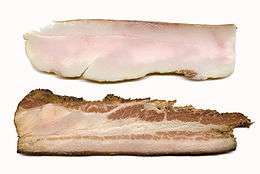
German smoked and baked pork belly used for cold cuts

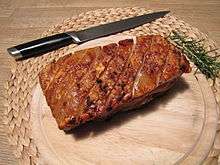
Some of the meanings of bacon overlap with the German-language term Speck. Germans use the term bacon explicitly for Frühstücksspeck ('breakfast Speck') which are cured or smoked pork slices. Traditional German cold cuts favor ham over bacon, however "Wammerl" (grilled pork belly) remains popular in Bavaria.
Small bacon cubes (called "Grieben" or "Grammerln" in Austria and southern Germany) have been a rather important ingredient of various southern German dishes. They are used for adding flavor to soups and salads and for speck dumplings and various noodle and potato dishes. Instead of preparing them at home from larger slices, they began to be sold ready made as convenience foods recently as "Baconwürfel" ("bacon cubes") in German retail stores.
Japan
In Japan, bacon (ベーコン)[29] is pronounced "bēkon". It is cured and smoked belly meat as in the US, and is sold in either regular or half-length sizes. Bacon in Japan is different from that in the US in that the meat is not sold raw, but is processed, precooked and has a ham-like consistency when cooked.[30] Uncured belly rashers, known as bara (バラ), are very popular in Japan and are used in a variety of dishes (e.g. yakitori and yakiniku).
United Kingdom and Ireland
A thin slice of bacon is known as a 'rasher'.[4] Bacon is usually described as either streaky or back:
- The term 'bacon' on its own does not specify the cut but typically refers to back bacon.
- Bacon from the pork belly, with streaks of meat and fat, is referred to as 'streaky bacon'.
- Bacon from the back of the pig is referred to as 'back bacon', and usually includes a streaky bit and a lean oval bit.
- Middle cuts with an eye of meat and an extended streaky section are common.
- Heavily trimmed back cuts which may consist of just the eye of meat are available.
Bacon may be cured in several ways; in particular it may be described as smoked or unsmoked. Many ways of curing add water to the meat; bacon sold as "dry cured" does not have added water. For example, in a shop a particular type may be described as "dry-cured unsmoked back bacon".[31]
Grilled[4] or fried bacon rashers are included in the traditional full breakfast, which varies slightly from country to country ("full Scottish", etc.).
United States
A side of unsliced bacon is known as a 'slab'.[32] An individual slice of bacon is known as a 'slice' or 'strip'.[4]
American bacons include varieties smoked with hickory, mesquite or applewood and flavourings such as chili pepper, maple, brown sugar, honey, or molasses.[33]
- The term 'bacon' on its own generally refers to strip bacon from the belly meat of the pig, which is the most popular type of bacon sold in the US.
- 'Canadian Bacon' or 'Canadian-style bacon' is made from the pork loin,[34] usually the lean ovoid portion (longissimus muscle or loineye).[24]
Bacon mania

The United States and Canada have seen an increase in the popularity of bacon and bacon-related recipes, dubbed "bacon mania". The sale of bacon in the US has increased significantly since 2011. Sales climbed 9.5% in 2013, making it an all-time high of nearly $4 billion in US. In a survey conducted by Smithfield, 65% of Americans would support bacon as their "national food".[35] Dishes such as bacon explosion, chicken fried bacon, and chocolate-covered bacon have been popularised over the internet,[36] as has using candied bacon. Recipes spread quickly through both countries' national media, culinary blogs, and YouTube.[37][38] Restaurants have organised and are organising bacon and beer tasting nights,[39] The New York Times reported on bacon infused with Irish whiskey used for Saint Patrick's Day cocktails,[40] and celebrity chef Bobby Flay has endorsed a "Bacon of the Month" club online, in print,[41] and on national television.[42]
Commentators explain this surging interest in bacon by reference to what they deem American cultural characteristics. Sarah Hepola, in a 2008 article in Salon.com, suggests a number of reasons, one of them being that eating bacon in the modern, health-conscious world is an act of rebellion: "Loving bacon is like shoving a middle finger in the face of all that is healthy and holy while an unfiltered cigarette smoulders between your lips."[43] She also suggests bacon is sexy (with a reference to Sarah Katherine Lewis' book Sex and Bacon), kitsch, and funny. Hepola concludes by saying that "Bacon is American".
Alison Cook, writing in the Houston Chronicle, argues the case of bacon's American citizenship by referring to historical and geographical uses of bacon.[37] Early American literature echoes the sentiment—in Ebenezer Cooke's 1708 poem The Sot-Weed Factor, a satire of life in early colonial America, the narrator already complains that practically all the food in America was bacon-infused.[44]
Bacon dishes
.jpg)
Bacon dishes include bacon and eggs, bacon, lettuce, and tomato (BLT) sandwiches, Cobb salad, and various bacon-wrapped foods (scallops, shrimp,[45][46][47] and asparagus). Recently invented bacon dishes include chicken fried bacon, chocolate covered bacon, and the bacon explosion. Tatws Pum Munud is a traditional Welsh stew, made with sliced potatoes, vegetables and smoked bacon. Bacon jam and bacon marmalade are also commercially available.
In the US and Europe, bacon is commonly used as a condiment or topping on other foods, often in the form of bacon bits. Streaky bacon is more commonly used as a topping in the US on such items as pizza, salads, sandwiches, hamburgers, baked potatoes, hot dogs, and soups. In the US, sliced smoked loin, which Americans call Canadian bacon, is used less frequently than the streaky variety, but can sometimes be found on pizza, salads, and omelettes.
Bacon is also used in adaptations of dishes; for example, bacon wrapped meatloaf,[48] and can be mixed in with green beans[49] or served sautéed over spinach.
Bacon fat

Bacon fat liquefies and becomes bacon dripping when it is heated. Once cool, it firms into lard if from uncured meat, or rendered bacon fat if from cured meat. Bacon fat is flavourful and is used for various cooking purposes. Traditionally, bacon grease is saved in British and southern US cuisine, and used as a base for cooking and as an all-purpose flavouring, for everything from gravy to cornbread[50] to salad dressing.[51]

If streaky pork belly bacon sliced in cubes is being used for lard preparation, as traditionally in Germany, the parts with higher melting temperatures are roasted and stay in the lard. The result is Griebenschmalz, a famous spread.
Bacon, or bacon fat, is often used for barding roast fowl and game birds, especially those that have little fat themselves. Barding consists of laying rashers of bacon or other fats over a roast; a variation is the traditional method of preparing filet mignon of beef, which is wrapped in rashers of bacon before cooking. The bacon itself may afterwards be discarded or served to eat, like cracklings.
One teaspoon (4 g or 0.14 oz) of bacon grease has 38 calories (40 kJ/g).[52] It is composed almost completely of fat, with very little additional nutritional value. Bacon fat is roughly 40% saturated.[52] Despite the disputed health risks of excessive bacon grease consumption, it remains popular in the cuisine of the American South.[53]
In the German case, Griebenschmalz has been substituted with apples and onions, first as a makeshift in times of needs but as well to lower the fat content. Instead of using gravies, German cuisine prefers sauces with a lower grease content, however smaller amounts of bacon fat and animal grease in general are being used frequently, e.g., for (sweet) cookies and cakes.
Nutrients
One 20-gram (0.7 oz) rasher of cooked streaky bacon contains 5.4 grams (0.19 oz) of fat, and 4.4 grams (0.16 oz) of protein.[54] Four pieces of bacon can also contain up to 800 mg of sodium, which is roughly equivalent to 1.92 grams of salt. The fat and protein content varies depending on the cut and cooking method.
68% of the food energy of bacon comes from fat, almost half of which is saturated.[55] Each ounce of bacon contains 30 milligrams of cholesterol (0.1%).[55][56]
Health concerns
Bacon has a large amount of sodium, and the consumption of a large amount of sodium has traditionally been considered to put a person at risk for heart disease and high blood pressure.[56]
Bacon is considered by many doctors to be unhealthy if eaten in excess.[56] A study conducted by researchers at the University of Zurich found a connection between eating processed meat and the risk of dying from heart disease or cancer.[56] Processed meats contain preservatives known as nitrates that, when absorbed by the human body, convert into nitrosamine, a chemical compound that could cause cancer.[56] A second study by researchers at Columbia University found that the consumption of cured meats increase a person's chances of developing chronic pulmonary disease.[56][57][58]
Researchers from the Harvard School of Public Health found in 2010 that eating processed meats (such as bacon) that are preserved by smoking, curing or salting, or with the addition of chemical preservatives, was associated with an increased risk of both heart disease and diabetes.[59] The same association was not found for unprocessed meat.[59]
A newly released publication about cancer research in the United Kingdom by the WHO says processed meats (like bacon or sausages) do cause cancer.[60]
Alternatives
Several alternatives to and substitutes for bacon have been developed for those who cannot or prefer not to eat standard pork bacon.
Turkey bacon

Turkey bacon is a popular alternative to bacon.[15][61] People may choose turkey bacon over real bacon due to health benefits, religious laws, or other reasons.[61] It is lower in fat and food energy than bacon,[15][61] but may be used in a similar manner (such as in a BLT sandwich).[61]
The meat for turkey bacon comes from the whole turkey and can be cured or uncured, smoked, chopped, and reformed into strips that resemble bacon.[15] Turkey bacon is cooked by pan-frying.[61] Cured turkey bacon made from dark meat can be 90% fat free.[62] The low fat content of turkey bacon means it does not shrink while being cooked and has a tendency to stick to the pan.[62]
Macon
Macon is another alternative to bacon, produced by curing cuts of mutton in a manner similar to the production of pork bacon.[63] Historically produced in Scotland, it was introduced across Britain during World War II as a consequence of rationing.[64][65] It is today available as an alternative to bacon, produced for the Muslim market and sold at halal butchers; it is largely similar in appearance to pork bacon except for the colour (which tends to be black and yellow).[66]
Vegetarian bacon
Vegetarian bacon, also referred to as fakon, veggie bacon, or vacon, is a product marketed as a bacon alternative that is available in supermarkets.[67] It has no cholesterol, is low in fat, and contains large amounts of protein and fibre.[67] Two slices contain about 74 calories.[67] Vegetarian bacon is usually made from marinated strips of tofu or tempeh.
Reception

Bacon Today states that bacon has a very valuable amount of protein that is "valuable to maintaining our energy levels and a fully functioning, healthy body".[68] Everything Tastes Better with Bacon, a book by Sara Perry, is a cookbook that compliments bacon's many uses in cooking.[69]
On the other hand, as with most meat products, producers of bacon have received heavy criticism for how their pigs are treated. Many petitions and protests have been made trying to raise awareness and change how producers treat their pigs. Many of these protests have turned out successful: for example, following NBC News's report of an undercover investigation of an abusive pig farm, Tyson Foods terminated their contract with the pig farm.[70] Similar to NBC's investigation, The Humane Society of the United States (HSUS) investigated Seaboard Foods, one of the pig breeding facilities that supply Walmart.[71] According to HSUS, the pigs were treated poorly and abused. Walmart spokesperson Diana Gee said, "As soon as we were made aware of the allegations, we immediately reached out to Seaboard to begin investigating the issue ... Pending our review, we will take any action necessary." Petitions also exist that oppose poor treatment of pigs, many of which state that the current treatment of pigs in factories is cruel and unethical.[72][73]
Bacon-flavoured products

The popularity of bacon in the United States has given rise to a number of commercial products that promise to add bacon flavouring without the labour involved in cooking it or the perceived negative qualities of bacon.
Bacon bits
Bacon bits are a frequently used topping on salad or potatoes, and a common element of salad bars.[15] They are usually salted. Bacon bits are made from either small, crumbled pieces of bacon;[15] in commercial plants they are cooked in continuous microwave ovens. Similar products are made from ham or turkey, and analogues are made from textured vegetable protein, artificially flavoured to resemble bacon.[74]
Other bacon-flavoured products
There is also a wide range of other bacon-flavoured products, including a bacon-flavoured salt (Bacon Salt),[15][75] Baconnaise (a bacon-flavoured mayonnaise),[15][76] Bacon Grill (a tinned meat, similar to Spam) and bacon ice cream.
In popular culture
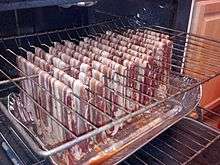
Bacon has been gaining popularity over the past decade.[77] It has become a fad on the internet.[78]
Epic Meal Time
Epic Meal Time, a cooking show based on YouTube, features bacon in many of their episodes. In one episode entitled Bacon Tree, Epic Meal Time creates a tree made out of bacon using over 2,000 strips of bacon.[79] In another episode entitled Boss Bacon Burger, over 400 strips of bacon are used to make a gigantic hamburger with bacon and other toppings.[80]
Rhett and Link
On 29 May 2012, the YouTubers Rhett and Link published a comedy video promoting the topical application of bacon as a cure-all. The video, "Rub Some Bacon on It", had received over eleven million views in September 2016.[81]
See also
|
References
- 1 2 Filippone, Peggy. "What is bacon". About.com. Retrieved 1 January 2014.
- 1 2 3 Moncel, Bethany. "What is Bacon?". About.com. Retrieved 1 January 2014.
- 1 2 "Bacon Cuts". James Whelan Butchers. Retrieved 3 January 2014.
- 1 2 3 4 Royer, Blake (21 April 2010). "A Guide to Bacon Styles, and How to Make Proper British Rashers". The Paupered Chef. Retrieved 2 January 2014.
- ↑ "Bacon". OED Online. Oxford University Press. 1989. 50016435.
- ↑ Hiskey, Daven (30 August 2010). "Origin of the Word "Bacon"". Today I Found Out. Retrieved 4 February 2014.
- ↑ "Eat cheap but well! Make a tasty beef in beer". Today. MSNBC. 30 April 2009. Archived from the original on 3 May 2009. Retrieved 13 May 2009.
- ↑ "Health and You". New Straits Times. 12 May 2009. Archived from the original on 27 June 2009. Retrieved 13 May 2009.
- ↑ "USDA Food Safety and Inspection Service: Glossary B". Food Safety and Inspection Service. Archived from the original on 3 May 2009. Retrieved 5 May 2009.
- ↑ Hui, Yiu H.; Bruinsma, L. Bernard; Gorham, J. Richard (2002). Food Plant Sanitation. CRC Press. p. 605. ISBN 978-0-8247-0793-4. Retrieved 5 May 2009.
- ↑ Randolph, Mary; Karen Hess (1984). The Virginia Housewife. University of South Carolina Press. pp. 18–19. ISBN 978-0-87249-423-7.
- ↑ Sarah F. McMahon, "Gender, Dietary Decisions, and Food Technology," in McGaw, Judith A. (1994). Early American technology: making and doing things from the colonial era to 1850. University of North Carolina Press. pp. 164–96. ISBN 978-0-8078-4484-7. Esp. pp. 186–89.
- ↑ "Definition of streaky bacon in English". Oxford Dictionaries. Retrieved 2 January 2014.
- 1 2 3 4 5 6 7 8 9 10 11 12 13 14 15 16 17 "Bacon Varieties". The Bacon Page. Retrieved 9 February 2014.
- 1 2 3 4 5 6 7 8 9 10 11 12 13 14 Moncel, Bethany. "What is Bacon?". About.com: Food Reference. Retrieved 8 February 2014.
- 1 2 Hiskey, Daven (4 May 2010). "Where Bacon Comes From On a Pig". Today I Found Out. Retrieved 8 February 2014.
- ↑ "Kiwi Bacon – All about bacon". Kiwi Bacon. Archived from the original on 22 February 2014. Retrieved 8 February 2014.
- ↑ "A Guide To Traditional British Back Bacon". The English Breakfast Society. 4 January 2014. Retrieved 8 February 2014.
- ↑ "Information and Statistics 2005" (PDF). Danish Bacon Company. 30 March 2005. Archived from the original (PDF) on 30 January 2006. Retrieved 6 May 2009
- ↑ "Jowl Bacon". Zingerman's. Retrieved 8 February 2014.
- ↑ "Food – Glossary – 'C' – 'Collar'". BBC. Archived from the original on 23 May 2006. Retrieved 2 January 2014.
- ↑ Wang, Chichi (8 May 2012). "The Nasty Bits: Ham Hock". Serious Eats. Retrieved 8 February 2014.
- ↑ Carter, Louisa. "Gammon recipes". BBC. Retrieved 8 February 2014.
- 1 2 "Cattleman's Beef Board & National Cattlemen's Beef Association." (PDF). Uniform Retail Meat Identity Standards. Archived from the original (PDF) on 27 March 2009. Retrieved 9 July 2007.
- ↑ "The Full English Breakfast". 4 January 2014. English Breakfast Society. Retrieved 8 February 2014.
- ↑ "bacon rind – definition of bacon rind by the Free Online Dictionary, Thesaurus and Encyclopedia.". Farlex, Inc. Retrieved 8 February 2014.
- ↑ "Food Service – Bacon". KR Castlemaine. Archived from the original on 1 October 2009. Retrieved 2 January 2014.
- 1 2 3 Canadian Oxford Dictionary, 2nd ed. (2004).
- ↑ "Japanese Meaning or Translation of – 'bacon'". Bdword. Retrieved 9 February 2014.
- ↑ "伊藤ハム | 商品情報 |". Itoham.co.jp. Retrieved 2 January 2014.
- ↑ Typical example of description as "Dry Cured Unsmoked Back Bacon"
- ↑ Hog, Boss. "Whiskey Maple Glazed Slab Bacon". Bacon Today. Retrieved 9 February 2014.
- ↑ R. W. Apple Jr. The Smoky Trail To a Great Bacon 16 February 2000 The New York Times
- ↑ Weinzweig, Ari (24 July 2008). "Canadian Peameal Bacon". Zingerman's Roadhouse. Archived from the original on 25 February 2009. Retrieved 15 March 2009.
- ↑ Passy, Charles (11 February 2014). "Bacon sales sizzle to all-time high". Market Watch. Retrieved 11 February 2014.
- ↑ "Get Your BBQ On: Bacon-Infused Webinar Sheds Light on Social Media Marketing Viral Marketing Sensation BBQ Addicts Join Marketbright for a Free Webinar on Marketing 2.0". Marketwire. 24 March 2009. Archived from the original on 26 April 2009. Retrieved 6 May 2009
- 1 2 Cook, Alison (5 March 2009). "It's a 'we love bacon' world: We're just lucky to be living—and dining—in it". Houston Chronicle. Retrieved 15 March 2009.
- ↑ "Candied Bacon Martini". Los Angeles Times. Retrieved 6 May 2009.
- ↑ "Bacon and Beer Tasting at Jimmy's No. 43". New York Barfly. 4 November 2008. Archived from the original on 20 April 2009. Retrieved 15 March 2009.
- ↑ Miles, Jonathan (13 March 2009). "Wear the Green but Don't Drink It". The New York Times. Archived from the original on 17 April 2009. Retrieved 15 March 2009.
- ↑ "Bacon of the Month Club". The Grateful Palate. Archived from the original on 22 March 2009. Retrieved 15 March 2009.
- ↑ "Food Gifts That Keep on Giving: From Utensils To Treats, Bobby Flay Likes To Give (Or Receive) These Presents". CBS News. 13 December 2007. Archived from the original on 8 May 2009. Retrieved 6 May 2009.
- ↑ Hepola, Sarah (7 July 2008). "Bacon mania: Why are Americans so batty for bacon? It's delicious, it's decadent – and it's also a fashion statement.". Salon.com. Retrieved 15 March 2009.
- ↑ Kay, Arthur (1998). "Ebenezer Cooke: The Sot-Weed Factor". Renascence editions. Retrieved 15 March 2009.
- ↑ Siegel, Helene (1997). Totally Shrimp Cookbook. Celestial Arts. p. 11. ISBN 978-0-89087-823-1.
- ↑ Wise, Jane E. (2005). The Culinary Guide for MSPI. Milk Soy Protein Intolerance. p. 7. ISBN 978-0-9764023-0-5.
- ↑ Daley, Bill (11 March 2001). "Chengdu Cuisine of China". Hartford Courant. p. 10. Retrieved 10 February 2009.
- ↑ "Recipe Bacon wrapped meatloaf". WKRG Mobile, Alabama. 10 April 2008. Archived from the original on 10 June 2008. Retrieved 2 January 2014.
- ↑ "Recipe Green Beans with Bacon". WKRG Mobile, Alabama. 28 July 2008. Archived from the original on 10 July 2009. Retrieved 2 January 2014.
- ↑ Rombauer, Irma; Rombauer Becker, Marion (1964). "Pan Gravy". The Joy of Cooking. Bobbs-Merrill Company. p. 322. ISBN 978-0-02-604570-4.
- ↑ Brown, Alton. "Bacon Vinaigrette with Grilled Radicchio". Archived from the original on 13 February 2008. Retrieved 13 January 2008.
- 1 2 "Nutritional Summary for Animal fat, bacon grease". nutritiondata.com. Retrieved 5 May 2009
- ↑ McDaniel, Rob. "From the Chef: Balance Essential to Southern Food, not just Bacon Drippings". SpringHouse at Crossroads. Retrieved 9 February 2014.
- ↑ "Calories in Bacon, Streaky, Cooked – Nutrition and Health Facts". Calorie Count. Retrieved 2 January 2014.
- 1 2 Magee, Elaine. "Can Bacon Be Part of a Healthy Diet?". WebMD. Retrieved 5 January 2014.
- 1 2 3 4 5 6 Jacques, Renee (12 November 2013). "9 Unfortunate Truths About Juicy, Scrumptious Bacon". The Huffington Post. Retrieved 10 January 2014.
- ↑ "Too much bacon 'bad for lungs'". BBC News. 17 April 2007. Retrieved 15 March 2009.
- ↑ "Chronic Obstructive Pulmonary Disease". The New York Times. 24 September 2008. Archived from the original on 19 March 2009. Retrieved 15 March 2009.
- 1 2 Micha, Renata; Mozaffarian, Dariush; Wallace, Sarah (17 May 2010). "Eating Processed Meats, but Not Unprocessed Red Meats, May Raise Risk of Heart Disease and Diabetes". Harvard School of Public Health. Archived from the original on 4 June 2010. Retrieved 3 June 2010.
- ↑ "Processed meats do cause cancer – WHO". Retrieved 27 October 2015.
- 1 2 3 4 5 Gold, Amanda (22 October 2008). "One turkey bacon stands out in the flock". San Francisco Chronicle. Retrieved 13 May 2009.
- 1 2 "Turkey Bacon Wins Support as Good Meat at Breakfast". Deseret News. 22–23 January 1991. Retrieved 13 May 2009.
- ↑ Shephard, Sue (2006). Pickled, Potted, and Canned: How the Art and Science of Food Preserving Changed the World. Simon and Schuster. p. 73. ISBN 0-7432-5553-4
- ↑ Footnote in Time Magazine mentions wartime use.
- ↑ George Orwell noted it in his wartime diary.
- ↑ Booley, Ashraf. "Macon: Bacon's Underrated Cousin". Woolworth's Taste. Retrieved 2 March 2015.
- 1 2 3 "Vegetarian Bacon". Archived from the original on 25 March 2012. Retrieved 18 June 2011.
- ↑ Hog, Boss. "Top 10 Reasons Bacon Is Actually HEALTHY For You!". Bacon Today. Retrieved 3 January 2014.
- ↑ Crooks, Laura (7 August 2002). "Let bacon add a little sizzle to your meal". The Spokesman-Review. Cowles Publishing Company. p. D1. Archived from the original on 6 September 2002.
- ↑ Schecter, Anna; Alba, Monica; Perez, Lindsay (20 November 2013). "Tyson Foods dumps pig farm after NBC shows company video of alleged abuse". NBC News. Archived from the original on 25 January 2014. Retrieved 3 January 2014.
- ↑ Zelman, Joanna (1 February 2012). "Seaboard Corporation Pig Treatment Challenged By Humane Society Investigation (GRAPHIC VIDEO)". The Huffington Post. Retrieved 3 January 2014.
- ↑ "Clarified – What are gestation crates?". CNN. 6 June 2012. Retrieved 9 February 2014.
- ↑ "Undercover Investigations: Exposing Animal Abuse". Mercy for Animals. Retrieved 9 February 2014.
- ↑ "Textured Vegetable Protein". Diversified Foods Inc. Archived from the original on 23 July 2008. Retrieved 15 March 2009.
- ↑ ABC News: 'Bacontrepreneurs' Building Bacon Empire
- ↑ "J & D's – Everything Should Taste Like Bacon". J & D's. Archived from the original on 2 March 2009. Retrieved 15 March 2009.
- ↑ DeYoung, Jeff (19 September 2013). "Bacon's rise demands attention to quality". Iowa Farmer Today. Retrieved 2 January 2014.
- ↑ Milian, Mark (1 April 2009). "Why the Internet loves bacon*". Los Angeles Times. Retrieved 2 January 2014.
- ↑ Morse, Felicity (22 December 2011). "Bacon Tree YouTube Video Made By Epic Meal Times Is Christmas Porker". The Huffington Post. Retrieved 1 January 2014.
- ↑ Ayrouth, Elie (15 May 2012). "This 'Bacon Boss Burger' Has Over 400 Bacon Strips and 109,165 Calories". Foodbeast. Retrieved 1 January 2014.
- ↑ Rhett and Link (29 May 2012). "Rub Some Bacon on It". Retrieved 17 September 2016.
External links
| Look up bacon in Wiktionary, the free dictionary. |
| Wikimedia Commons has media related to Bacon. |
| Wikiquote has quotations related to: Bacon |


